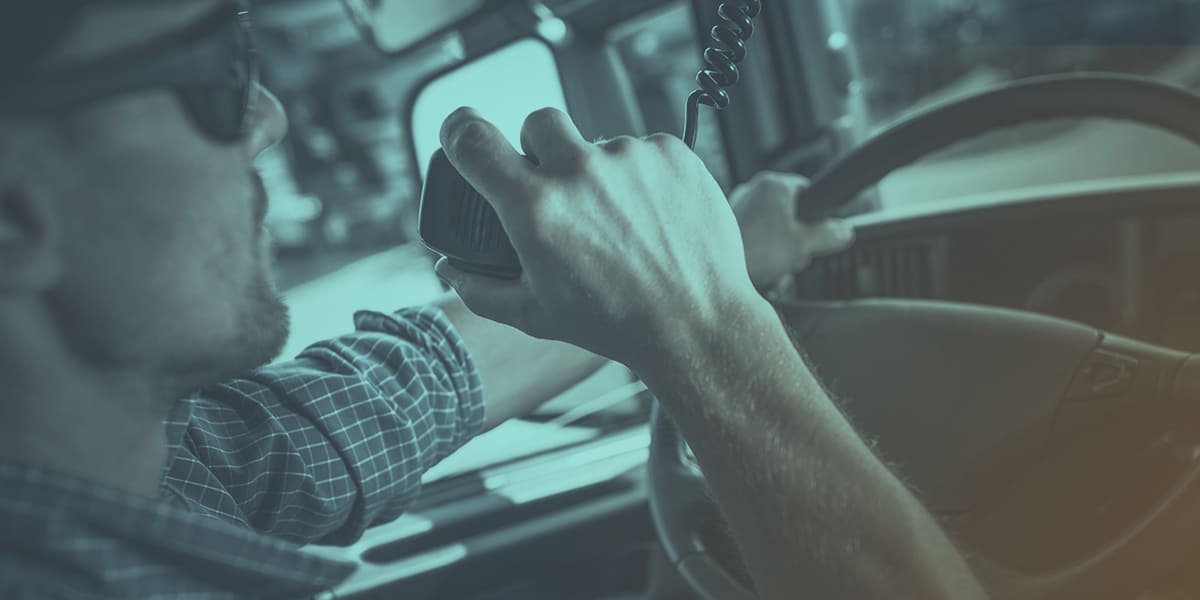
The Complete List of CB 10 (Citizens Band Radio) Codes
CB radios represent the original social media for truckers. The specialized language truckers developed and popularized during the golden age of CB radios in the 70s, 80s, and 90s is still alive and well today. A cornerstone of this industry’s unique language is the CB 10 codes, first developed in the 1940s and later standardized in 1955. These CB radio codes were established to allow brevity and ease of messaging – a critical communication advantage for an industry facing the 1973 oil crisis.
The 1973 oil crisis had an immediate and negative impact on the transportation space. The U.S faced fuel shortages, gas station closures, and reduced speed limits nationwide. Adapting to the situation, commercial truck drivers began using CB radios to communicate which gas stations were open, how to avoid speed traps, and where to avoid traffic jams and accidents. These tactics helped to keep the nation’s supply chain moving and trucking companies to survive. By the time the oil crisis ended in 1974, CB radios were standard equipment in commercial trucks across the country, and the trucker’s language was firmly rooted.
CB radios are no longer essential equipment, yet they can still become your only lifeline during dangerous weather conditions. Despite being replaced as the primary means of communication, the trucker’s language that CB radios popularized still survives. It is widely used by veteran drivers and enthusiastically picked up by new operators. Learning the CB radio vernacular and CB 10 Radio Codes is not only an important communication skill, but it also indoctrinates you into the lifestyle and culture of trucking.
For newcomers to the trucking industry and road warrior veterans needing to brush up on their language skills, here is the complete CB 10 Codes list.
The Definitive List of Citizens Band Radio or CB 10 Codes, and what they mean.
- 10-1: Receiving Poorly or I can’t hear you
- 10-2: Receiving well or I can hear you
- 10-3: Stop transmitting
- 10-4: Message received
- 10-5: Relay message
- 10-6: Busy, stand by
- 10-7: Out of service
- 10-8: In service
- 10-9: Repeat Message
- 10-10: Transmission completed, standing by
- 10-11: Talking too rapidly
- 10-12: Visitors present
- 10-13: Advise weather/road conditions
- 10-16: Make pick up at ___
- 10-17: Urgent Business
- 10-18: Anything for us?
- 10-19: Nothing for you, return to base
- 10-20: Your current location
- 10-21: Call by telephone
- 10-22: Report in person to [location]
- 10-23: Stand by
- 10-24: Completed last assignment
- 10-25: Can you contact [person’s name]
- 10-26: Disregard Last Information/Cancel Last Message
- 10-27: I’m moving to channel [channel number]
- 10-28: Identify your station
- 10-29: Time is up for contact
- 10-30: Does not conform to FCC Rules
- 10-32: I will give you a radio check
- 10-33: Emergency traffic at this station
- 10-34: Trouble at this station, help needed
- 10-35: Confidential information
- 10-36: Need correct time
- 10-37: Wrecker needed at [location]
- 10-38: Ambulance needed at [location]
- 10-39: Your message delivered
- 10-41: Please tune to channel [channel #]
- 10-42: Traffic accident at [location]
- 10-43: Traffic jam
- 10-44: I have a message for you
- 10-45: All units within range please report
- 10-50: Break channel
- 10-60: What is next message number?
- 10-62: Unable to copy, please use phone
- 10-65: Awaiting your next message or assignment
- 10-67: All units comply
- 10-70: Fire at [location]
- 10-71: Proceed with transmission in sequence
- 10-73: Speed trap
- 10-75: You are causing interference
- 10-77: Negative contact
- 10-84: My telephone number is
- 10-85: My address is
- 10-91: Talk closer to the mike
- 10-92: Your transmitter is out of adjustment
- 10-93: Check my frequency on this channel
- 10-94: Please give me a long count
- 10-95: Transmit dead carrier for 5 seconds
- 10-99: Mission completed; all units secure
- 10-100: Bathroom break
- 10-200: Police needed at [location]
Conclusion
Every profession comes with specialized terminology and jargon that newcomers to the industry must learn – trucking is no exception. Listen to conversations at truck stops, in the driver’s lounge, or elsewhere. You can easily spot the veterans by their familiarity and frequency of words, phrases, and CB 10 codes unique to trucking. If trucking is your chosen career, then learning to speak the language of your trade is a communication skill you should develop.
For some, the unique language truckers use is considered part of the trucking culture and a heritage worth protecting. Now that you have a handle on the trucker lingo, you can join in on a conversation with a road veteran or in the next CB talk while you’re on the road.
eCapital Freight Factoring
eCapital is a tech enabled lender with specialized services for the transportation industry. We know trucking. We know the language you speak and the challenges you face every day. You do everything in your power to pick up and deliver freight safely and on time – we do everything in our power to deliver the funds you need to grow and thrive. Through innovation and advanced technology, we provide more money, more ways, and faster than competing lenders. Our freight factoring is the best in the industry. Other supporting services include:
- Fuel discount programs
- Free, unlimited credit checks on shippers and brokers
- Five Star load board
- Dispatch software
For more information about how freight factoring supports your trucking company through changeable conditions, from economic uncertainty to business growth opportunities, visit eCapital.com
ABOUT eCapital
Since 2006, eCapital has been on a mission to change the way small to medium sized businesses access the funding they need to reach their goals. We know that to survive and thrive, businesses need financial flexibility to quickly respond to challenges and take advantage of opportunities, all in real time. Companies today need innovation guided by experience to unlock the potential of their assets to give better, faster access to the capital they require.
We’ve answered the call and have built a team of over 600 experts in asset evaluation, batch processing, customer support and fintech solutions. Together, we have created a funding model that features rapid approvals and processing, 24/7 access to funds and the freedom to use the money wherever and whenever it’s needed. This is the future of business funding, and it’s available today, at eCapital.

